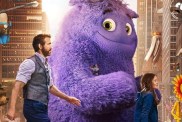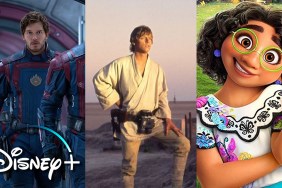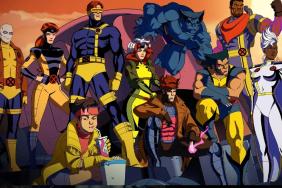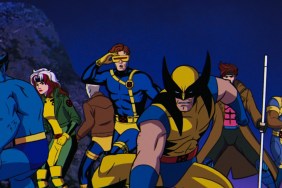
Meet Bolt. He’s the canine star who gives the title to Disney’s latest animation; one that boasts an unprecedented 3-D experience and one for which new techniques had to be invented by the studio’s ever-resourceful artists. With production just wrapping up, Disney gave ComingSoon.net the chance to go behind the scenes and experience firsthand the incredible level of detail that goes into a project as ambitious as Bolt.
The story of Bolt begins in Hollywood, CA where an American White Shepherd (voiced by John Travolta) has spent his entire life as the super-powered lead in a popular television series. Alongside his young owner, Penny (Miley Cyrus), Bolt appears on TV sets across the nation, saving the day and ridding the world of evil. For Bolt, however, there’s no line between fiction and reality and he doesn’t realize that the powers and abilities he has on the show don’t carry over into real life.
When an accident has Bolt shipped from Hollywood to New York City, he sets off across America to be reunited with Penny. Convinced that his odyssey is the fault of on-screen villain Doctor Calico (Malcolm McDowell), Bolt captures a streetwise alley cat named Mittens (Susie Essman) whom he mistakes for one of the Doctor’s minions. Herself convinced that Bolt is insane, Mittens still has no choice but to join the young pup in his quest. The triad of traveling house pets is soon complete when the pair is joined by Rhino (Mark Walton), a hamster who, having spent his entire life in a plastic ball in front of a television set, is as convinced as Bolt that the dog is every bit a superhero.
Helming the project is the directorial team of Chris Williams and Byron Howard. Though it’s the first time directing for both of them, Williams’ time at Disney goes back to Mulan and Howard’s to Pocahontas. Together, they’ve worked out a clear look for Bolt from a variety of inspirations.
Williams and Howard showed off two scenes from Bolt. Though they were the same two scenes that were shown earlier this year to Comic-Con goers, this was the first time the footage had been screened with full 3-D effects. Both Williams and Howard were extremely proud of the 3-D in Bolt, explaining that, for the first time, Disney was developing the 3-D throughout production, rather than adding it after the fact. This allowed for 3-D to be used to help tell the story instead of inserting it after the fact.
The first scene was from an episode of the ficitional-within-a-fiction episode of Bolt where Penny and Bolt are chased through the streets of San Francisco by masked motorcycling ninja henchmen (click new photo above for bigger version!) and enormous black helicopters. The directors were offered a challenge by Executive Producer John Lasseter: Make the “Bolt” TV show so exciting that a network would actually want to show it. To that end, the look and feel of the sequence apes Michael Bay’s artificially stylized action. Never, though, does it venture into parody and instead offers an interesting contrast to the “real world” rest of the film.

In the second clip, we’re well into the story; Mittens has been captured by animal control and locked in an animal shelter. Bolt and Rhino work out a plan to save her, springing a nighttime jailbreak against unsuspecting guards. It’s very interesting to see the differences in art direction here, not just of the look and feel of the 2-D environment but of the 3-D one as well. In the same way that the action sequence can go for extreme angles and rapid cutting, this sequence offers a more muted (but still action-packed) look at Bolt’s world. There’s a lot more subtlety to some of the effects including a rather impressive 3-D lens flare.
The look of Bolt’s American journey was largely inspired by both the paintings of Edward Hopper and the cinematography of Vilmos Zsigmond (especially his work in Robert Altman’s McCabe & Mrs. Miller). To this end, new software was created that allowed 3-D environments to be painted as though by brushstroke. Mimicking Hopper, detail is planned to drop off from the foreground to the background, capturing the painterly look and feel. To a similar end, Art Director Paul Felix and Director of Lighting Adolph Lusinksy took to the road, moving across the United States to find appropriate looks and area-specific details to add to the film.
Robert Neuman, the Stereographic Supervisor, was ultimately responsible for the 3-D in the film and utilized a “3-D Score” to chart the emotional intensity of each shot. Mapped out exactly like a shooting script or storyboard, the 3-D Score examined every frame and determined how intensely the 3-D should effect the viewer. The key, Neuman explained, was creating a balance between “comfort and immersion.” More important than pulling off an effect for effect’s sake, the viewer needs to be pulled in to the 3-D world and to just accept it as part of the storytelling.
The biggest problem to overcome, Neuman explained, was something called “window violations” which is a problem that exists uniquely in transforming 2-D to 3-D. In a normal film, the viewer’s vision is limited by the confines of the theater screen. In Bolt, though, some objects projected right to the edge should — in a 3-D environment — be visible on beyond the end of the screen. A number of creative tricks are employed to trick the viewer’s eye including one known as a “floating window”; an artificial screen, slightly smaller than the actual one, is simulated within the 3-D, allowing for objects to drop right off the edge.
Taken downstairs to the recording studio, I was given the chance to see how the voicing process worked and got to, myself, take on the role of Bolt for a practice scene. Mark Walton, who provides the voice of Rhino the hamster, has worked for Disney for years as an animator. It’s a common process for animators to step in and voice characters for temporary tracks and — every now and then — the voice fits so well that the actor sticks. Walton was rather doubtful that he’d ever win the role but kept his fingers crossed until, one day, he was brought in for a recording session and given a script that included the line, “…and Mark Walton is the voice of Rhino!”

The upstairs offices are decked out with a full Bolt theme. Every production is allowed to, early on, design the look and feel of their workspace. This one included a number of tributes to Hopper-esque Americana, including a diner-styled (and fully operational) cereal bar.
In addition to images from the film, the walls included a number of interesting bulletin boards; On one, everyone in the office had pinned up photographs of their own pets across from one of “Production Babies,” featuring 37 babies born during the film’s production. Another, down the hall, charted a “Beard Off” the male crew members underwent to see how long they could grow their facial hair during the production process.
The office was also home to Doink!, a crew hamster who provided MAYA animators with a reference to Rhino’s movements. Animal movements, that is, crossed with human facial expressions. For that, the office houses a special room where crew can record themselves doing the same lines and grab the expressions they like to translate over to Rhino.
It’s clear that all around, Disney is embracing 3-D technology in a major way and that, very soon, the Bolt offices will make room for the studio’s next production. (In fact, there was a door with a small poster for Pixar’s 2012 Phillip K. Dick adaptation, King of the Elves which, sadly, had to remain closed for now) But if the level of care and creativity that has gone into Bolt can come close to being matched in future projects, animation fans are definitely in for some treats.
Bolt opens in theaters on November 21.









